Abstract
With the large-scale development and grid connection of renewable energy, hydropower faces more intense and frequent peak shaving and frequency regulation, giving rise to water level fluctuations and frequently forced sluice adjustments at hydropower stations. This paper proposes a model that combines “offline calculation” and “online search”. First, feasible sluice opening combinations for different water levels at each hydropower station are calculated offline, and a sluice operation strategy table is constructed. Subsequently, an optimal sluice operation strategy is searched online according to the real-time water level and various regulatory requirements. As an example, we select three hydropower stations in the middle reach of the Dadu River in China, namely, Pubugou, Shenxigou, and Zhentouba. The results show that the total number of adjustments of the sluices of the cascade hydropower stations was reduced from 1195 to 675, a reduction of 43.5%, and the leading hydropower station, Pubugou, met water level control requirements, whereas the fluctuations in the water level of the two downstream daily regulating hydropower stations, Shenxigou and Zhentouba, were reduced by 1.38 m and 0.55 m, respectively. The results indicate that the sluices of hydropower stations were optimally used under high-intensity peak shaving and frequency regulation.
1. Introduction
A typical cascade hydropower development is composed of a leading power station with a large storage capacity and multiple run-of-the-river power stations whose storage capacity is regulated on a daily basis [1,2]. With the recent large-scale development and connection of renewable energy to the grid, hydropower stations face more intense and frequent peak shaving and frequency regulation tasks [3,4,5]. For power stations subjected to daily regulation with poor storage control, frequent changes in load instructions are likely to cause large fluctuations in the water level. During the flood season, the drastic changes in water level greatly increase the risk of flood control operation in cascade reservoirs. Thus, sluices must be used to regulate reservoir levels and downstream flow to ensure the safety of reservoir dams, and downstream objects need to be protected. Traditional decision-making regarding the management of power station sluices relies on scheduling handbooks or human experience. However, high-intensity peak shaving and frequency regulation have led to more complex and repeated changes in upstream and downstream hydraulic conditions, meaning that traditional calculation methods based on water balance have difficulties complying with the accuracy requirements of water level regulation. In turn, this causes a mismatch in the flow of the upstream and downstream power stations, resulting in frequent adjustments to the operation and opening of sluices. Furthermore, small power stations are often close to each other and have close hydraulic connections. Transmission times vary from several minutes to several hours, requiring sluice operation decisions to be generated quickly. Thus, the traditional decision-making method is labor-intensive, high-risk, and insufficiently responsive. In addition, the nonlinear relationship between water level, flow rate, and sluice opening, as well as the time-varying characteristics of the sluice opening flow rate with the reservoir water level, further compound the complexity of the problem. Therefore, solving the two complex problems of accuracy and efficiency of decision-making regarding sluice operation is the key to optimizing power stations under high-intensity peak shaving and frequency regulation.
In recent years, scholars have conducted research from different perspectives, such as energy and revenue optimization, flood control scheduling, and joint operation of sluices. In terms of energy and revenue optimization, scholars have established different models and compared their optimization effects. For example, De Ladurantaye D [6] presented both a deterministic and a stochastic mathematical model to maximize the profits obtained by selling electricity produced through a cascade of dams and reservoirs in a deregulated market, and the results demonstrated the superiority of the stochastic model over the deterministic one. Avesani D [7] presented a comparative assessment of revenues provided by short-term optimizations driven by two econometric models, which may be beneficial for hydropower companies to enhance the expected revenues from storage hydropower systems, especially those characterized by large storage capacity. Regarding flood control scheduling [8,9,10], reservoir flood control scheduling has the characteristics of being multiconstraint, high-dimension, nonlinearity, and difficult to solve [11]. The overall approach has evolved from one or a few reservoirs securing a single flood protection object to multi-objective refined and comprehensive scheduling of a large group of reservoirs for multiple flood protection objects across a whole basin, including optimal scheduling modeling and solving, regular scheduling rule extraction, and flood risk assessments. For example, He et al. [12] proposed the improved sparrow algorithm (ISSA) combining Cauchy mutation and reverse learning strategy, which provided a new and effective way to solve the problem of flood control optimization of reservoir groups. Wang [13] proposed a multi-objective modeling and optimization method for flood control, scheduling large reservoir clusters based on different pre-defined frameworks. This effectively solved the complex optimization problem of scheduling schemes for large-scale reservoir clusters. Xu et al. [14] proposed an optimal scheduling model for flood resource utilization to derive optimal scheduling rules for the Three Gorges in flood season, considering flood risk. Huang et al. [15] proposed a multi-objective operation and risk decision-making model to provide strategies for real-time reservoir control to reduce flood risk. Zhu et al. [16] proposed the main steps that constitute optimal flood control decision-making and performed a flood control risk assessment, which showed improved reliability of flood control decisions. Nevertheless, these studies were mostly concerned with flood events, with the water level or flow rate as decision variables, and they rarely focused on the operation of power station sluices. In terms of sluice utilization, Su et al. [17] proposed an optimal scheduling model for reservoir flood control considering spillway constraints to generate a more accurate, executable flood control scheduling strategy. Kim et al. [18] proposed an optimal sluice decision-making method based on the particle swarm optimization algorithm, which can be effectively used to determine optimal sluice scheduling rules and generate sluice opening and closing strategies during the flood season. However, these studies tended to focus on individual power stations and in-depth research on the joint use of sluices in groups of cascade power stations has not yet been reported.
This paper proposes a method named the “Sluice Decision Method Based on Sluice Operation Strategy Table”, which consists of “offline calculation” and “online search” to enhance the accuracy and efficiency of sluice operation in a group of cascade power stations under high-intensity peak shaving and frequency regulation. First, an “offline calculation” of the feasible sluice operation scheme at different water levels is conducted, and a sluice operation strategy for the cascade hydropower stations is developed. Then, according to the current status and scheduling requirements of the group of cascade power stations, the optimal sluice control strategy is searched online in the strategy master list. Finally, a case study is conducted in the middle-course cascade power stations of the Dadu River.
2. Methods
2.1. Model Principles and Calculation Steps
The use of sluices in cascade hydropower stations requires simultaneous decisions on the combination of sluices and the extent to which each sluice is opened. Cascade power stations often have dozens or even hundreds of different sluices; thus, numerous options exist, with a complex nonlinear relationship between the water level, flow rate, and degree of sluice opening. In addition, the variation in the sluice flow with the reservoir water level with time further exacerbates the complexity of the problem. In the practical scheduling of hydropower stations, the traditional optimization decision-making method for sluices involves manually calculating the water level process for various sluice operation schemes at each time period and selecting sluice schemes based on this calculation. However, this method is susceptible to the curse of dimensionality, leading to potential adverse effects on computational efficiency and accuracy.
To this end, in this study, we first calculated all feasible sluice operation schemes at different water levels based on the rules of the symmetrical opening of sluices of each power station and established a master list of sluice operation strategies for power stations, which was stored to reduce real-time decision-making computations. In the real-time decision-making process, based on the control objectives of fewer adjustments of sluice and water level stability, the optimal sluice operation strategy for cascade power stations was generated using an “online search” of the master list of sluice operation strategies for power stations. Usually, the opening of sluices does not change significantly over a short period of time; hence, the real-time decision-making model uses a 15-min calculation scale. The model uses power and water forecast information as boundaries, simulates and deduces the operation of each power station in the cluster of cascade power stations within 24 h, and determines whether the intra-day scheduling process of the reservoir meets the scheduling requirements based on simulation deduction results; if so, the current sluice opening is maintained, and otherwise, based on the forecast information and scheduling requirements for the future, an “online search” is conducted to find the optimal sluice control strategy. A flowchart illustrating the calculation process is presented in Figure 1.

Figure 1.
Flowchart of calculation for optimal use of sluices in a group of power stations.
2.2. Establishment of Sluice Operation Strategy Table Based on “Offline Calculation”
As the operation mode and requirements of the sluices at each power station are different, the feasible sluice combinations under different conditions are also different, and the decision is affected by many variables. The inclusion of all sluices in the group of cascade power stations in the optimization calculation could lead to the curse of dimensionality. Therefore, it is necessary to conduct an “offline calculation” of the feasible sluice combinations for different water levels and flow conditions, construct a sluice operation strategy table, and store the feasible combinations to achieve accurate and rational sluice regulation. We selected four indicators, namely water level, combination of sluices, sluice opening, and discharge flow rate, of each power station to construct a sluice operation strategy table for each station as follows:
Step 1: Identifying the water level interval between normal and dead levels of each power station in increments of 0.1 m.
Step 2: Determining the feasible combinations of sluice options at different water levels. Therefore, it is necessary to analyze the feasible combination of sluices at different water levels according to the sluice operation mode and operation requirements and retain the feasible combination of sluices at each water level. In the table, an open sluice is represented by 1, and a closed sluice is represented by 0.
Step 3: Enabling discrete sluice openings in increments of 0.1 m based on the feasible sluice combinations at different water levels. Considering the adverse effects of the zigzag currents on the safe operation of power stations, when multiple sluices need to be opened at each power station, it is necessary to ensure that these sluices are opened in a consistent manner.
Step 4: Calculating the sum of the flow rate of each sluice under each scheme for different water levels, sluice combinations, and sluice opening combination schemes, using the flow curve of each discharge facility. Considering the numerous scenarios covered by the sluice operation strategy table, it is impractical to display all of them. Therefore, this paper presents an example using a hydropower station with five sluices to demonstrate the sluice operation strategy table when the water level is h m, and the discharge rate is Q m3·s−1. Refer to Table 1 for specific details, eij represents the i-th sluice in the j-th scheme.

Table 1.
Example of sluice operation strategy table.
2.3. “Online Search”-Based Sluice Operation Strategy Generation
After building the sluice operation strategy table, a sluice operation strategy is efficiently generated using the “online search” method. First, the operational status and processes of each cascade power station under different incoming water and load conditions are deduced based on the power requirements [19]. Based on the results of each cascade power station, it is determined whether the water level and flow rate of each station meet the control requirements, and if the control requirements are met, the extent to which the sluices are opened remains unchanged; otherwise, to meet the water level and flow constraints, an “online search” is conducted for the optimal control strategy with the objective of performing the minimum number of sluice operations.
2.3.1. Objective Function
The primary optimization objective of the model is to minimize the number of sluice operations by optimizing the decision on the opening of each by optimizing the opening of each sluice. However, in calculations, situations often arise where the objective function values of multiple schemes are equal. To address such situations, the model introduces a second optimization objective function. Considering that a significant change in flood discharge flow and resulting fluctuations in water level may occur if the amplitude of two adjacent adjustments is too large, the secondary optimization objective is to minimize the opening change amplitude of adjacent sluice adjustments. Only when there are multiple solutions that result in equal values for the primary optimization objective function will the secondary objective function values of these solutions be calculated. The solution with the best secondary objective function value will then be selected among them. The objectives of the model are as follows:
In the formula, i is the number of sluices, i = 1, 2, …, n; n is the total number of sluices; t is the sequence number of the calculation period, t = 1, 2, …, T; T is the total number of time periods; is the number of adjustments during time period t of sluice i in the power stations; and is the opening of the sluice i during the period t and t − 1.
2.3.2. Constraints
- Water balance [20] constraint
In the formula, i is the number of the hydropower stations, i = 1, 2, …, N, N is the total number of cascade hydropower stations; t is the sequence number of the calculation period, t = 1, 2, …, T; T is the total number of time periods, T = 96; and are the reservoir storage volumes of the hydropower station at and , respectively; is the average inlet flow of the hydropower station at ; is the average outlet flow of the hydropower station at ; is the computational interval, = 15 min.
- b.
- Power quantity balance constraint
In the formula, i is the number of the hydropower stations, i = 1, 2, …, N, N is the total number of cascade hydropower stations; t is the sequence number of the calculation period, t = 1, 2, …, T; T is the total number of time periods, T = 96; is the output power of the hydropower station in time period ; is the total power generation; is the computational interval, = 15 min.
- c.
- Power balance constraint
In the formula, i is the number of the hydropower stations, i = 1, 2, …, N, N is the total number of cascade hydropower stations; t is the sequence number of the calculation period, t = 1, 2, …, T; T is the total number of time periods, T = 96; and are the total output power of cascade power stations and the hydropower station in time period .
- d.
- Power station output constraint
In the formula, i is the number of the hydropower stations, i = 1, 2, …, N, N is the total number of cascade hydropower stations; t is the sequence number of the calculation period, t = 1, 2, …, T; T is the total number of time periods, T = 96; is the load of the hydropower station in time period ; and are the upper and lower limits of output of hydropower station in time period .
- e.
- Flow rate balance constraint
In the formula, i is the number of the hydropower stations, i = 1, 2, …, N, N is the total number of cascade hydropower stations; t is the sequence number of the calculation period, t = 1, 2, …, T; T is the total number of time periods, T = 96; , , and are the outflow, power generation flow, and waste flow, respectively, of hydropower station in time period .
- f.
- Power generation flow rate constraint
In the formula, i is the number of the hydropower stations, i = 1, 2, …, N, N is the total number of cascade hydropower stations; t is the sequence number of the calculation period, t = 1, 2, …, T; T is the total number of time periods, T = 96; and are the upper and lower limits of the power generation flow rate of hydropower station in time period , respectively; are the power generation flow of hydropower station in time period .
- g.
- Discharge flow rate constraint
In the formula, i is the number of the hydropower stations, i = 1, 2, …, N, N is the total number of cascade hydropower stations; t is the sequence number of the calculation period, t = 1, 2, …, T; T is the total number of time periods, T = 96; and are the upper and lower limits of the discharge flow rate of hydropower station in time period , respectively.
- h.
- Water level constraint
In the formula, i is the number of the hydropower stations, i = 1, 2, …, N, N is the total number of cascade hydropower stations; t is the sequence number of the calculation period, t = 1, 2, …, T; T is the total number of time periods, T = 96; is the water level of hydropower station in time period ; and are the upper and lower limits of the water level of hydropower station in time period , respectively.
- i.
- Outbound flow rate variation constraint
In the formula, i is the number of the hydropower stations, i = 1, 2, …, N, N is the total number of cascade hydropower stations; t is the sequence number of the calculation period, t = 1, 2, …, T; T is the total number of time periods, T = 96; and , respectively, are the variation and maximum variation in the outflow of the power station between time period and ; and are the outflow of the power station in time period and .
2.3.3. Search Strategy
The method proposed in this paper utilizes the sluice operation strategy table, which eliminates a large number of solutions that do not meet operational requirements, shortens the decision space, and avoids the complexities of multi-objective solving by prioritizing the two optimization objectives. Therefore, the use of the traversal search algorithm in this model can meet the requirements of calculation accuracy and efficiency and can avoid getting stuck in local optimal solutions. The specific calculation steps are as follows:
Step 1: Taking the opening of each sluice of each hydropower station at the initial calculation time of the model as the initial solution and deducing the water level and flow rate based on this initial solution.
Step 2: Adjusting the sluice opening one hour in advance if the power station’s water level/flow rate is projected to exceed the limit and making an immediate adjustment if less than one hour remains until the moment the limit will be exceeded. If it is necessary to adjust the sluice, recording the time of adjustment.
Step 3: Searching for the set of sluice opening combinations among the sluice operation strategy table based on the water level of the hydropower station at the time of adjustment.
Step 4: Searching for a set of feasible sluice opening combinations that satisfy the various constraints among the set of sluice combinations .
Step 5: Calculating the objective function (Equations (1) and (2)) value of each scheme in the set of feasible sluice opening combinations , and selecting the best scheme from . A flowchart illustrating the process of “online search” is presented in Figure 2.
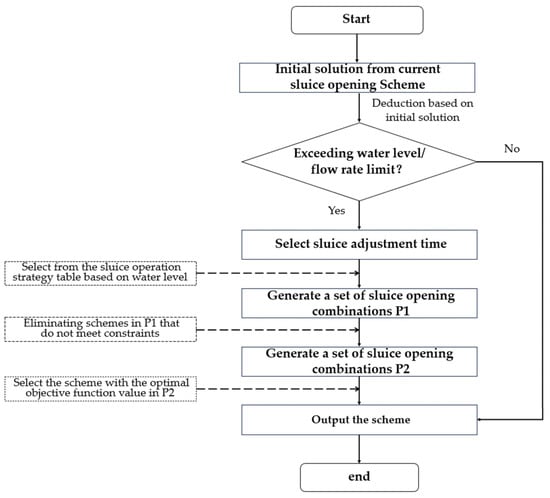
Figure 2.
Flowchart of “online search” -based sluice operation strategy generation.
3. Case Study
3.1. Overview of the Study Area
The Dadu River basin [21] is the fifth largest hydropower base in China. It is the main peak shaving and frequency regulation power source for the Sichuan power grid and a key barrier for flood control in the Yangtze River Basin and surrounding area. The Pubugou, Shenxigou, and Zhentouba power stations (hereinafter referred to as “Pu–Shen–Zhen”) in the middle reaches of the Dadu River are mainly used for power generation. On average, they receive grid load adjustment instructions approximately twice per minute. Owing to the complex inflows between areas and cross-sectional tidal restrictions, the three power stations have been afflicted by a long-term power and water mismatch. In particular, the two downstream power stations that were being regulated daily had poor storage performance and short hydropower transmission times, resulting in high-intensity peak shaving and frequency regulation, which produced severe fluctuations in the water level, requiring the frequent use of sluices for water level safety control.
The Pubugou power station flood discharge facilities include three spillways and a flood discharge tunnel. The spillways have three inlet sluices with openings of 12 m × 17 m (width × height). When open, the sluices should be uniformly open, and the frequency of use should be reduced when the water level is below 840 m. The size of the flood discharge tunnel opening is 11.0 m × 11.5 m (width × height), and long-term use with a small degree of opening should be avoided. The Shenxigou flood discharge facilities include three sluices and two flood discharge tunnels. There are three sluices with openings of 7.0 m × 17.0 m (width × height), which adhere to the principle of “uniform symmetry”. These sluices have two gates with an outlet size of 9 m × 11.5 m (width × height). The reservoir level should be higher than 650 m when opening, and operations should be avoided in the sluice vibration area. The Zhentouba flood discharge facilities include five sluices, with a total of five openings, each 8.0 m × 16 m (width × height). When operated under low flow rate conditions, asymmetric opening of sluices and excessive discharge by a single sluice should be avoided. The main feature parameters of the three stations are listed in Table 2. The geographical location of the Dadu River Basin is shown in Figure 3.

Table 2.
Feature parameters of power stations in the middle reaches of the Dadu River Basin.
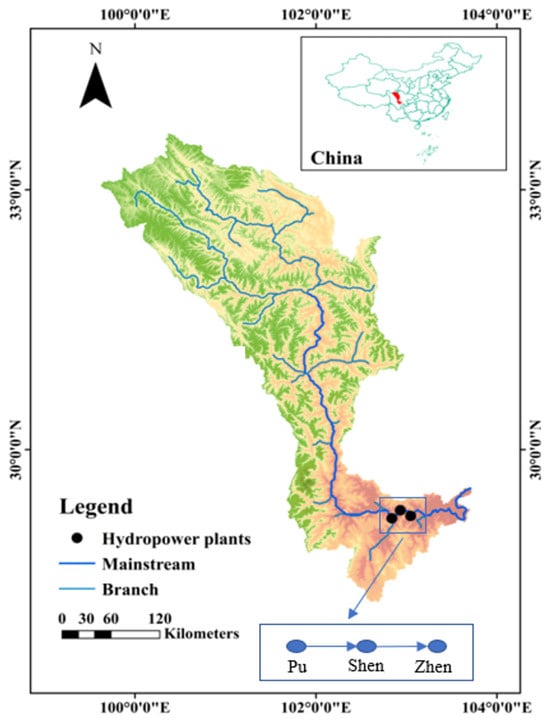
Figure 3.
Schematic diagram of cascade power stations in the Dadu River Basin.
3.2. Data Sources
In this study, the period from 5 July to 5 August 2019 was selected as a typical period. The data used in model calculations include the total load process of the Pu–Shen–Zhen station every 15 min, inflow of Pubugou every 15 min, runoff process between Pubugou and Shenxigou every 15 min, runoff process between Shenxigou and Zhentouba every 15 min, water level process of each station every 15 min, and sluice opening process.
3.3. Analysis and Discussion
3.3.1. Load Process Analysis
In conducting an exhaustive examination of the actual and planned outputs of the Pu–Shen–Zhen cascade power station over the course of a month, a conspicuous dissimilarity between the two datasets comes to the forefront. The maximum deviation between the actual and planned outputs of the Pu–Shen–Zhen cascade power station amounts to a substantial 2682 MW, which represents a significant deviation of 68.4% from the initially projected output. Further analysis reveals an average deviation of 488 MW, indicative of a significant variance equivalent to 14.6% of the planned output value when considering the average deviation percentage. Remarkably, close to 12% of the analyzed time period exhibits deviations surpassing the threshold of 1000 MW.
Additionally, the actual output process exhibits highly volatile fluctuations, characterized by substantial gaps between peak and valley levels, with deviations exceeding 1500 MW, accounting for a notable 32% of the maximum output. These findings provide compelling evidence of the arduous tasks undertaken by the three stations within the Pu–Shen–Zhen cascade power system, which are responsible for high-intensity peak shaving and frequency regulation activities. Given the elevated frequency and magnitude of load changes, these stations face the formidable challenge of ensuring grid stability and operational efficacy. A comprehensive visualization of these findings is provided in Figure 4 and Figure 5 for reference. Among them, Figure 4 shows the Pu-Shen-Zhen output variation process with 15-min intervals, 7/5 represents 5 July 2019 at 00:00 (This is also the same in the following figures), and Figure 5 shows the distribution frequency of deviation between planned output and actual output.
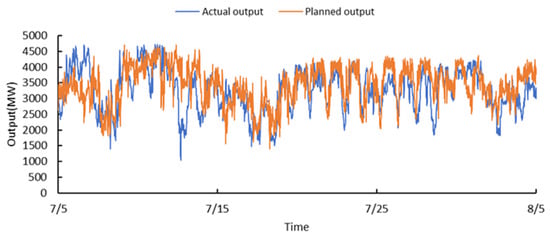
Figure 4.
Actual and planned outputs of Pu–Shen–Zhen.
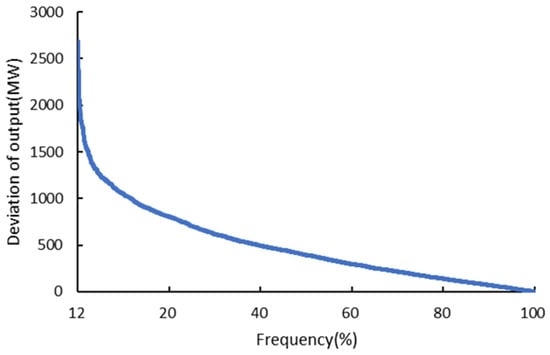
Figure 5.
Frequency curve of the difference between actual and planned outputs of Pu–Shen–Zhen.
The temporal variation between the actual and planned output processes exhibits an irregular and capricious nature. To conduct a meticulous analysis, a representative day, 11 July 2019, was selected for a detailed examination. Notably, throughout this particular day, the planned output showcases a persistent fluctuation in the vicinity of 4000 MW. It is worth highlighting that the planned output demonstrates a commendable convergence with the actual output, harmoniously synchronized until the early afternoon, prior to 12:00. However, subsequent to this temporal threshold, a subtle but discernible decline can be seen in the actual output. Finally, after 18:00, a marked precipitous descent is encountered, in stark contrast to the planned output’s swift resumption to its prior trajectory following a minor ephemeral dip. As a consequence, a substantial deviation between the actual and planned outputs emerges, reflecting the intricacies inherent in the dynamic interplay between these two factors. The variation between actual and planned outputs at different times on 11 July 2019, with 15-min intervals, is depicted in Figure 6 (This is also the same in the following figures).
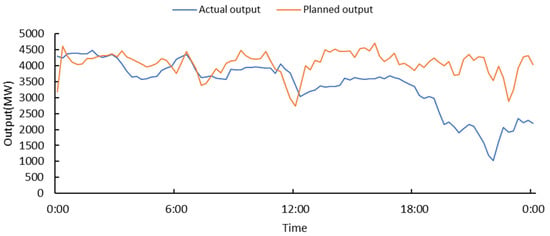
Figure 6.
Actual and planned outputs of Pu–Shen–Zhen on July 11.
The inherent randomness and unpredictability in the total load of the Pu–Shen–Zhen system pose significant challenges in effectively managing the daily water level of the power station. To accommodate the frequent fluctuations in load instructions, the daily regulation hydropower station experiences sharp rises and falls in its water level, which compromises the station’s safety. This unfavorable situation necessitates constant sluice adjustments to regulate the water level. The following section provides a detailed analysis of the water level and sluice scheduling processes.
3.3.2. Analysis of Water Level Process
To complete the power generation task of each power station, this study simulated the scheduling process of the power stations for the next 24 h, predicted the risk of each power station exceeding their water level and flow rate limits, and adjusted sluices in advance to meet the regulation and control requirements of each power station. Pubugou has an incomplete annual regulating capacity and requires water level control, with objectives that should be completed as far as possible. Following rolling optimization, the water level of the Pubugou power station was controlled at 840.62 m, which is 0.31 m above the target water level of 840.31 m and meets the water level control requirements. The two stations of Shenxigou and Zhentouba should ensure that the water level is as stable as possible. Before optimization, the water level at Shenxigou fluctuated between 655.11 and 658.85 m, and the lowest water level was only 0.11 m from the dead water level, which posed a significant safety risk. After optimization, the water level at Shenxigou power station was controlled between 656.51 and 658.87 m; thus, the range was reduced to 1.38 m, and the lowest water level was 1.51 m from the dead water level, thereby avoiding the risk of the reservoir emptying. Before optimization, the water level at Zhentouba fluctuated between 618.61 and 622.96 m, and the lowest water level was only 0.61 m from the dead water level. After optimization, the water level of Zhentouba was in the range of 619.15 to 622.95 m, reducing the fluctuation to 0.55 m, and the lowest water level was 1.15 m from the dead water level, which prevented the water level from falling near the dead storage level and improved the scheduling operation of the power station. The process of water level before and after optimization of Pu-Shen-Zhen with 15-min intervals is shown in Figure 7.
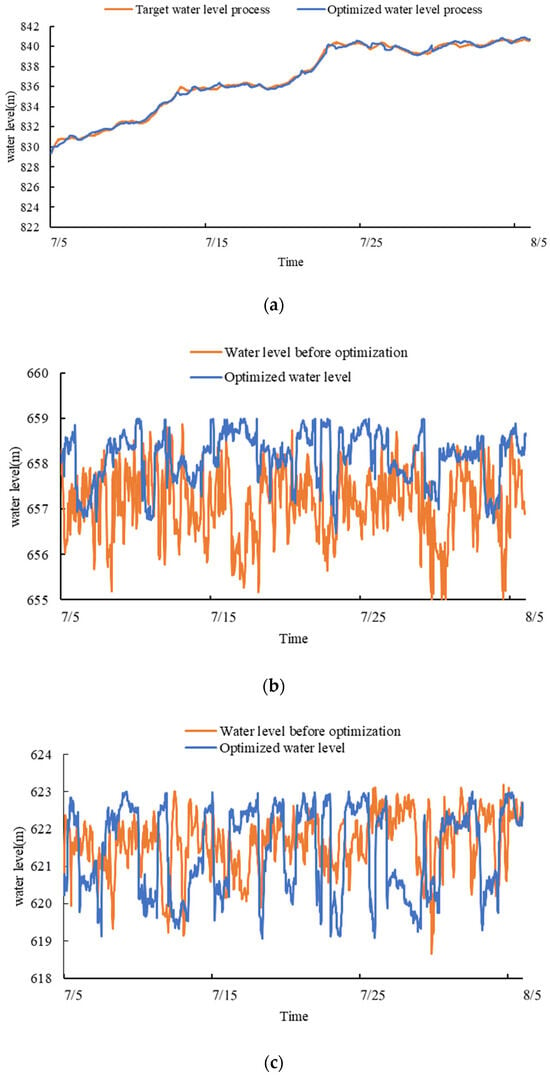
Figure 7.
(a) Water level process of Pubugou power station; (b) Water level process of Shenxigou power station; (c) Water level process of Zhentouba power station.
3.3.3. Analysis of the Sluice Operation Process
The sluice scheduling of power stations is based on traditional manual experience, and the sluice scheduling process often encounters the problems of frequent opening and closing sluices, multiple adjustments, and unsound sluice operation processes. The Shenxigou and Zhentouba stations have small storage capacities, and their reservoir water levels tend to rise and fall steeply due to the influence of the upstream reservoir, resulting in the forced use of sluices to make adjustments, which is not conducive to the safe operation of reservoirs and increases the pressure on workers.
In this study, the combination of offline calculations and online searches not only eliminated irrational feasible sluice solutions and improved the scientific basis of sluice decision-making but also reduced the number of sluice operations and relieved pressure on workers. Following optimization, the total number of sluice movements at the Pu–Shen–Zhen stations was reduced by 43.5%, from 1195 to 675. Sluice movements were reduced by 37.4% at Pubugou, 59.7% at Shenxigou, and 18.1% at Zhentouba. The numbers of sluice adjustments at each power station are listed in Table 3, Table 4 and Table 5.

Table 3.
The adjustment times of the sluices at Pubugou hydropower station.

Table 4.
The adjustment times of the sluices at Shenxigou hydropower station.

Table 5.
The adjustment times of the sluices at Zhoutouba hydropower station.
In order to fully compare the differences before and after optimization on a long-term scale, this study conducted an optimization of the sluice operation process for one month at 15-min intervals. The specific operation of each sluice with 15-min intervals is shown in Figure 8. In Figure 8, the dashed line represents before optimization, and the solid line represents after optimization. It can be seen from the figure that, before optimization, unsound practices occurred, such as frequent opening and closing within a short period of time and frequent small changes in the extent to which sluices were opened. At Shenxigou power station, in particular, the degree of openness of all five sluices repeatedly changed. After optimization, the operations of sluices at each power station became more regular, and the opening of each sluice became more stable, enhancing the scientificity and accuracy of sluice decision-making.
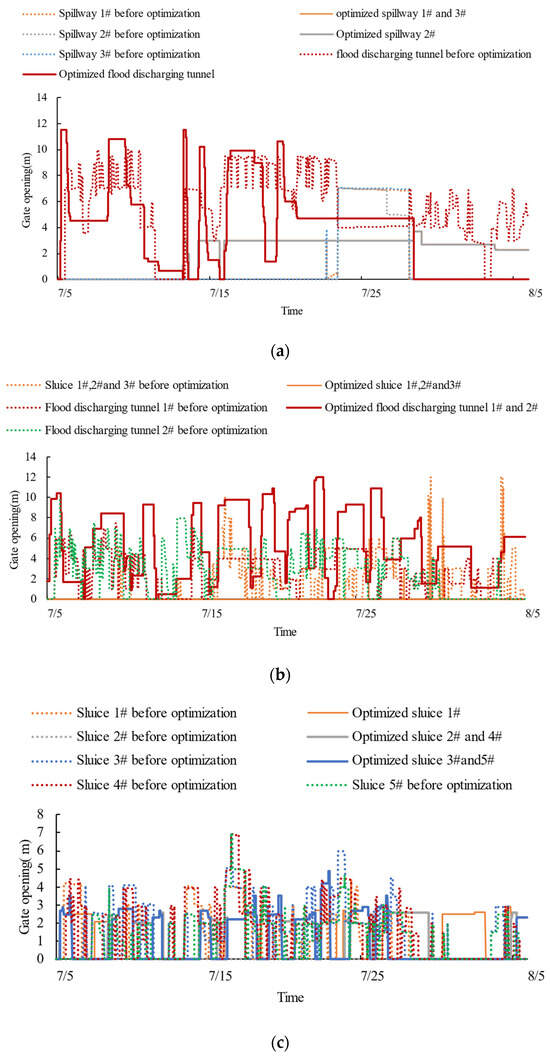
Figure 8.
(a) Pubugou power station sluice operation process; (b) Shenxigou power station sluice operation process; (c) Zhentouba power station sluice operation process.
The current gate scheduling process predominantly relies on manual experience-based scheduling. However, due to the inherent limitations of manual scheduling, dispatchers face challenges in accurately predicting the flow and water level trends of the future cascade power station group. Consequently, they struggle to select the most optimal gate operation plan, leading to the undesirable phenomenon of repeated opening adjustments and frequent gate openings and closures within the power station.
To provide a comprehensive analysis, we consider 8 July 2019 as a representative day, focusing on the intraday gate scheduling process. At the Shenxigou hydropower station, at 01:00, the gate openings for the 1# and 2# spillway tunnels were initially increased from 5.5 m to 6.5 m and 7.5 m, respectively. However, after maintaining this configuration for 30 min, the openings were subsequently decreased. Furthermore, at 10:00, the opening of the 2# flood discharge tunnel was adjusted from 5.5 m to closed. However, after a brief 15-min interval, the gate was reopened to 3.0 m. Such inconsistencies and frequent adjustments in gate openings highlight the limitations of manual scheduling, which fails to consider future water flow trends and optimal gate configurations.
Alternatively, by leveraging a model that comprehensively considers future water flow trends and various gate combinations, a more refined approach to gate scheduling can be achieved. The model’s optimized gate opening adjustments only occur once during a 24-h period, specifically at 11:30, effectively avoiding the irrational occurrence of frequent gate opening changes during actual dispatching. Similarly, at the Zhentouba hydropower station, the impact of upstream gate operations in the actual dispatching process resulted in frequent changes in gate openings at 01:30, 11:00, and 20:00. The specific process of sluice operation with 15-min intervals on 8 July 2019 is shown in Figure 9, and the comparison parts mentioned above have been marked with red frame in the Figure 9. However, through the application of the model optimization, the number of gate opening adjustments is significantly reduced, resulting in a more regular and rational gate operation method.
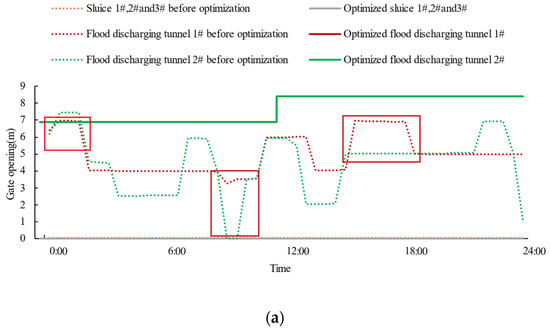
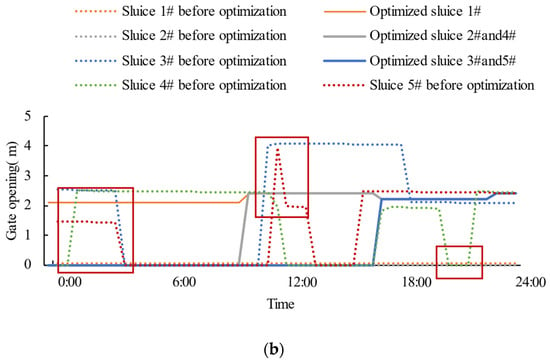
Figure 9.
(a) Shenxigou power station sluice operation process on July 8 and (b) Zhentouba power station sluice operation process on July 8.
By addressing the shortcomings of manual scheduling and embracing the advancements offered by model optimization, the gate scheduling process can achieve greater accuracy, efficiency, and stability, minimizing unnecessary fluctuations and improving the overall operational performance of the power station.
4. Conclusions
In this study, in view of the frequent operation of sluices in the group of cascade power stations under high-intensity peak shaving and frequency regulation, a joint-optimized operation model of sluices in the group was established. A sluice operation strategy table was created via offline calculations to ensure rational and timely decision-making with respect to sluice opening. Based on the initial state of each power station and water forecast information, we simulated the water level of each reservoir for the next 24 h and then conducted an online search for the optimal sluice operation strategy to automate sluice opening at each station. The main conclusions are summarized as follows:
(1) The method proposed in this paper efficiently addressed the problem of frequent sluice operations at the Pu–Shen–Zhen cascade power stations under high-intensity peak shaving and frequency regulation and enhanced the scientific basis of decision-making of the power station group scheduling. The total number of times the sluices of the cascade power stations were used was reduced from 1195 to 675, a reduction of 43.5%.
(2) The method proposed in this paper can reduce the fluctuation amplitude of water level in daily regulating power stations and ensure the safety of cascade power station operation while meeting the requirements of water level control in the leading power station. The optimized water level of Pubugou differs from the target water level by a mere 0.31 m, whereas the water level fluctuations of the two downstream daily regulating power stations of Shenxigou and Zhentouba were reduced by 1.38 m and 0.55 m, respectively.
In recent years, the large-scale development and connection of renewable energy has placed greater requirements on cascade hydropower scheduling. In the future, the method proposed in this paper can be improved through the following aspects:
(1) Advanced algorithms such as series methods [22] and heuristic algorithms can be used to solve the model proposed in this paper. The use of data mining [23,24,25], artificial intelligence [26,27,28], and digital twins [29,30] could also be further explored in the future to further improve the accuracy and timeliness of scheduling decisions.
(2) This study was conducted in the Dadu River Basin of China, and can also be conducted in multiple basins in the future to further improve the scientific and universal nature of this method.
Author Contributions
Conceptualization, S.M. and X.W.; Methodology, S.M.; Software, Y.L.; Validation, T.Q. and J.L.; Formal analysis, X.W.; Investigation, T.Q., J.L.; resources, S.M., T.Q. and J.L.; data curation, Y.L.; writing—original draft preparation, S.M.; writing—review and editing, X.W.; visualization, S.M.; supervision, X.W.; project administration, S.M. and X.W.; funding acquisition, X.W. All authors have read and agreed to the published version of the manuscript.
Funding
This research was funded by the National Key Research and Development Program of China, grant number 2019YFE0105200, Intelligent Scheduling and Optimal Operation of Cascade Hydropower Stations based on Spatiotemporal Big Data, 2020–2022.
Data Availability Statement
All data and models that support the findings of this study are available from the corresponding author upon reasonable request.
Acknowledgments
We have immense gratitude for the people of the Dadu River Basin Production Command Center for their funding and data support. We are very grateful for the technical support provided by the College of Water Conservancy and Hydropower Engineering at Hohai University.
Conflicts of Interest
Author Shiyu Mou, Tian Qu, Jia Li was employed by the company Dadu River Basin Production Command Center, China Energy Investment. The remaining authors declare that the research was conducted in the absence of any commercial or financial relationships that could be construed as a potential conflict of interest.
References
- Galletti, A.; Avesani, D.; Bellin, A.; Majone, B. Detailed simulation of storage hydropower systems in large alpine watersheds. J. Hydrol. 2021, 603, 127125. [Google Scholar] [CrossRef]
- Nazemi, A.; Wheater, H.S. On inclusion of water resource management in earth system models—Part 1: Problem definition and representation of water demand. Hydrol. Earth Syst. Sci. 2015, 19, 33–61. [Google Scholar] [CrossRef]
- He, S.; Gao, H.; Liu, J.; Chen, Z. Distribution system planning considering peak shaving of energy stations. Appl. Energy 2022, 312, 118692. [Google Scholar] [CrossRef]
- Wang, P.; Yuan, W.; Su, C.; Wu, Y.; Lu, L.; Yan, D.; Wu, Z. Short-term optimal scheduling of cascade hydropower plants shaving peak load for multiple power grids. Renew. Energy 2022, 184, 68–79. [Google Scholar] [CrossRef]
- Rana, M.M.; Atef, M.; Sarkar, M.R.; Uddin, M.; Shafiullah, G.M. A Review on Peak Load Shaving in Microgrid-Potential Benefits, Challenges, and Future Trend. Energies 2022, 15, 2278. [Google Scholar] [CrossRef]
- De Ladurantaye, D.; Gendreau, M.; Potvin, J.Y. Optimizing profits from hydroelectricity production. Comput. Oper. Res. 2009, 36, 499–529. [Google Scholar] [CrossRef][Green Version]
- Avesani, D.; Zanfei, A.; Marco, N.D.; Galletti, A.; Ravazzolo, F.; Righetti, M.; Majone, B. Short-term hydropower optimization driven by innovative time-adapting econometric model. Appl. Energy 2022, 310, 118510. [Google Scholar] [CrossRef]
- Chen, S.; Zhang, Y.; Dan, L.I. Study on constant outflow model for reservoir flood control operation and its application. Adv. Water Sci. 2021, 32, 683–693. [Google Scholar] [CrossRef]
- Abdelal, Q.; Al-Rawabdeh, A.; Al Qudah, K.; Hamarneh, C.; Abu-Jaber, N. Hydrological assessment and management implications for the ancient Nabataean flood control system in Petra, Jordan. J. Hydrol. 2021, 601, 126583. [Google Scholar] [CrossRef]
- Jain, S.K.; Shilpa, L.S.; Rani, D.; Sudheer, K.P. State-of-the-art review: Operation of multi-purpose reservoirs during flood season. J. Hydrol. 2023, 618, 129165. [Google Scholar] [CrossRef]
- Wang, W.; Tian, W.; Chau, K.; Zang, H.; Ma, M.; Feng, Z.; Xu, D. Multi-Reservoir Flood Control Operation Using Improved Bald Eagle Search Algorithm with ε Constraint Method. Water 2023, 15, 692. [Google Scholar] [CrossRef]
- He, J.; Liu, S.-M.; Chen, H.-T.; Wang, S.-L.; Guo, X.-Q.; Wan, Y.-R. Flood Control Optimization of Reservoir Group Based on Improved Sparrow Algorithm (ISSA). Water 2023, 15, 132. [Google Scholar] [CrossRef]
- Wang, Q.; Li, A.; Lu, C. Multi-objective Optimization of Large-scale Multi-reservoir Flood Control Operation. J. Phys. Conf. Ser. 2022, 2333, 012016. [Google Scholar] [CrossRef]
- Xu, Z.X.; Mo, L.; Zhou, J.Z.; Zhang, X. Optimal dispatching rules of hydropower reservoir in flood season considering flood resources utilization. A case study of Three Gorges Reservoir in China. J. Clean. Prod. 2023, 388, 135975. [Google Scholar] [CrossRef]
- Huang, X.; Xu, B.; Zhong, P.A.; Yao, H.; Yue, H.; Zhu, F.; Lu, Q.; Sun, Y.; Mo, R.; Li, Z. Robust multi-objective reservoir operation and risk decision-making model for real-time flood control coping with forecast uncertainty. J. Hydrol. 2022, 605, 127334. [Google Scholar] [CrossRef]
- Zhu, F.L.; Zhong, P.A.; Sun, Y.M.; Yeh, W.G. Real-Time Optimal Flood Control Decision Making and Risk Propagation Under Multiple Uncertainties. Water Resour. Res. 2018, 53, 10635–10654. [Google Scholar] [CrossRef]
- Su, C.; Wang, P.; Yuan, W.; Cheng, C.; Zhang, T.; Yan, D.; Wu, Z. An MILP based optimization model for reservoir flood control operation considering spillway sluice scheduling. J. Hydrol. 2022, 613, 128483. [Google Scholar] [CrossRef]
- Kim, Y.G.; Sun, B.Q.; Kim, P.; Jo, M.B.; Pak, G.H. A study on optimal operation of sluice-controlled reservoir system for flood control based on PSO algorithm combined with rearrangement method of partial solution groups. J. Hydrol. 2021, 593, 125783. [Google Scholar] [CrossRef]
- Zhiqiang, J.; Hui, Q.; Changming, J.; Zhongkai, F.; Jianzhong, Z. Two Dimension Reduction Methods for Multi-Dimensional Dynamic Programming and Its Application in Cascade Reservoirs Operation Optimization. Water 2017, 9, 634. [Google Scholar] [CrossRef]
- Song, J.H.; Her, Y.; Kang, M.S. Estimating Reservoir Inflow and Outflow from Water Level Observations Using Expert Knowledge: Dealing with an Ill-Posed Water Balance Equation in Reservoir Management. Water Resour. Res. 2022, 58, e2020WR028183. [Google Scholar] [CrossRef]
- Sun, Y.; Zhu, F.; Chen, J.; Li, J. Risk Analysis for Reservoir Real-Time Optimal Operation Using the Scenario Tree-Based Stochastic Optimization Method. Water 2018, 10, 606. [Google Scholar] [CrossRef]
- Turkyilmazoglu, M. Nonlinear problems via a convergence accelerated decomposition method of adomian. Comput. Model. Eng. Sci. 2021, 127, 1–22. [Google Scholar] [CrossRef]
- Huang, K.; Yuan, J.; Zhou, Z.; Zheng, X. Analysis and evaluation of heat source data of large-scale heating system based on descriptive data mining techniques. Energy 2022, 251, 123834. [Google Scholar] [CrossRef]
- Ruidas, D.; Saha, A.; Chowdhuri, I.; Pal, S.C.; Towfiqul Islam, A.R.M. Application of novel data-mining technique based nitrate concentration susceptibility prediction approach for coastal aquifers in India. J. Clean. Prod. 2022, 346, 131205. [Google Scholar] [CrossRef]
- Attari, M.; Ejlaly, B.; Heidarpour, H.; Ala, A. Application of Data Mining Techniques for the Investigation of Factors Affecting Transportation Enterprises. IEEE Trans. Intell. Transp. Syst. 2022, 23, 9184–9199. [Google Scholar] [CrossRef]
- Feng, Z.K.; Shi, P.F.; Yang, T.; Niu, W.J.; Zhou, J.Z.; Cheng, C.T. Parallel cooperative search algorithm and artificial intelligence method for streamflow time series forecasting. J. Hydrol. 2022, 606, 127434. [Google Scholar] [CrossRef]
- Cui, F.; Al-Sudani, Z.A.; Hassan, G.S.; Afan, H.A.; Ahammed, S.J.; Yaseen, Z.M. Boosted artificial intelligence model using improved alpha-guided grey wolf optimizer for groundwater level prediction. Comparative study and insight for federated learning technology. J. Hydrol. 2022, 606, 127384. [Google Scholar] [CrossRef]
- Hadadi, F.; Moazenzadeh, R.; Mohammadi, B. Estimation of actual evapotranspiration. A novel hybrid method based on remote sensing and artificial intelligence. J. Hydrol. 2022, 609, 127774. [Google Scholar] [CrossRef]
- Zhao, D.; He, Q.; Yu, J.; Guo, M.; Fu, J.; Li, X.; Ni, M. A data-driven digital-twin model and control of high temperature proton exchange membrane electrolyzer cells. Int. J. Hydrogen Energy 2022, 47, 8687–8699. [Google Scholar] [CrossRef]
- Huang, Z.F.; Soh, K.Y.; Islam, M.R.; Chua, K.J. Digital twin driven life-cycle operation optimization for combined cooling heating and power-cold energy recovery (CCHP-CER) system. Appl. Energy 2022, 324, 119774. [Google Scholar] [CrossRef]
Disclaimer/Publisher’s Note: The statements, opinions and data contained in all publications are solely those of the individual author(s) and contributor(s) and not of MDPI and/or the editor(s). MDPI and/or the editor(s) disclaim responsibility for any injury to people or property resulting from any ideas, methods, instructions or products referred to in the content. |
© 2024 by the authors. Licensee MDPI, Basel, Switzerland. This article is an open access article distributed under the terms and conditions of the Creative Commons Attribution (CC BY) license (https://creativecommons.org/licenses/by/4.0/).